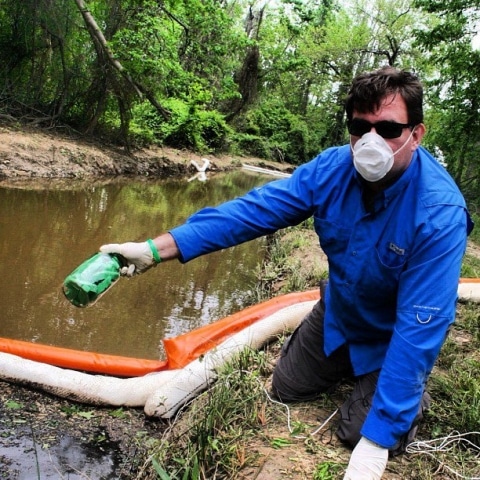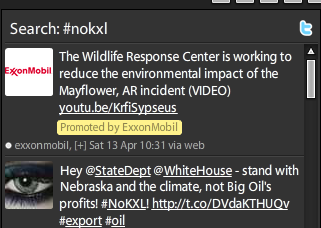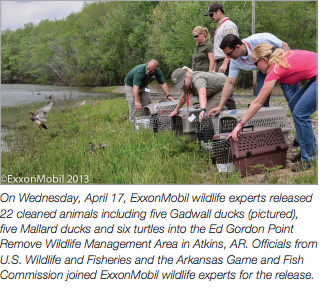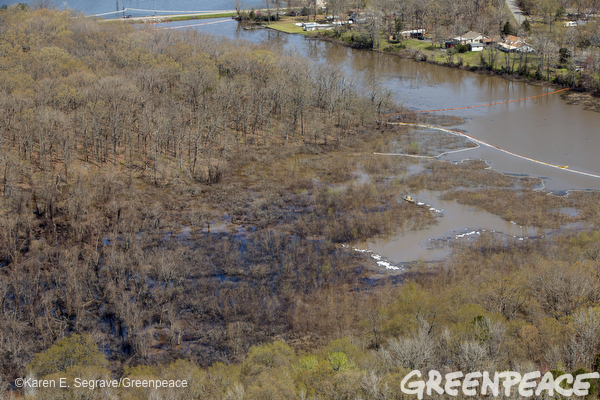ExxonMobil would sure like you to think that everything is just fine down in Mayflower, Arkansas. That the roughly 5,000 barrel tar sands crude spill was regrettable, but the town will be soon restored to its unspoiled state. That, in terms of clean up, they’re totally on it.
I mean, just look at their workers scrubbing away on the oiled ducks and turtles in this sleek little video:
ExxonMobil is so eager for you to see these images of their toothbrush-wielding sudsy soap brigade that they paid to promote the videos on Twitter. For at least two days earlier this month, anyone searching or tracking the #noKXL tag on Twitter would’ve seen this:
“The Unified Command cleanup operations continue to transition from emergency response to the longer-term work of remediation and restoration,” reads a press release from Tuesday, comfortingly. The worst is behind us. We got through it. Now watch us release these ten ducks back into the lake.
And as for those less fortunate animals that didn’t survive the spill, well don’t worry about that: “the majority of the impacted wildlife have been reptiles, mostly venomous snakes.” Just scary snakes! Seriously, they wrote that.
And don’t worry about Lake Conway either. The oil was stopped before reaching the “main body” of the lake, one of the most popular fishing and recreation spots in the region.
Except, back in the real world, oil had reached a cove in the lake. “”I don’t understand where this distinction is coming from. …The cove is part of Lake Conway,” Arkansas Attorney General Dustin McDaniel told reporters, as reported by InsideClimate News.
Meanwhile, a private company running water tests is sounding a much harsher alarm. “Yes, there’s oil in Lake Conway and there’s oil downstream flowing into the Arkansas River,” said Scott Smith, president and CEO of Opflex Solutions, a water quality testing and oil cleanup company.
Smith explains that while ExxonMobil is only testing the surface and bottom of the lake, his tests take a full “fingerprint” of the whole water column.
Obviously, as the head of an oil cleanup company, Smith has some vested interest in these results, and we’re working to get a look at their findings. Opflex told me, “The results are still preliminary and we are not releasing official reports at this time, but will release findings as they come.”
In the meantime, here’s a video produced by the Opflex team on the ground in Mayflower, so you can judge for yourself.
Local station KATV has also reported about the Opflex results, and has accounts from Mayflower residents of oil and oil-coated wildlife sightings in areas where ExxonMobil claims that the oil never reached.
As we learned in the Enbridge Kalamazoo River spill, the “dilbit disaster,” diluted bitumen is much harder to clean up than conventional crude, in large part because it sinks in bodies of water and doesn’t float for easy retrieval.
Knowing that the oil spilled from Pegasus was a heavy tar sands crude (referred to by ExxonMobil as Wabasca Heavy crude but considered tar sands by authorities in Canada), it stands to reason that surface tests wouldn’t be enough to determine if a body of water was truly free of tar sands oil.
We will follow up with the final Opflex results when we have them.
Photo: Opflex
Subscribe to our newsletter
Stay up to date with DeSmog news and alerts









